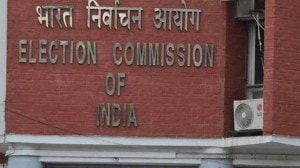Jitendra Singh at Idea Exchange: ‘If we put these – deep sea, space, Himalayas – to optimum use, we won’t have to wait till 2047 for Viksit Bharat’
Dr Jitendra Singh, as the Minister of State for science and space, has overseen the opening up of the space sector. In these five years, the sector has grown in size and revenue
 (Right) Jitendra Singh, Union Science Minister, in conversation with Anonna Dutt, Principal Correspondent, The Indian Express (Express Photo/Renuka Puri)
(Right) Jitendra Singh, Union Science Minister, in conversation with Anonna Dutt, Principal Correspondent, The Indian Express (Express Photo/Renuka Puri)Jitendra Singh, Minister of State for science and space, on bioeconomy-driven futures, space research and why there has been a drop in UPSC civil services vacancies. The session was anchored by Anonna Dutt, Principal Correspondent, The Indian Express
Anonna Dutt: Recently, we did the Space Docking Experiment (SpaDeX), a historic achievement for ISRO. What kind of scientific mission will we see in the next few years?
SpaDeX is a reflection of the advancements in the last few years and the kind of missions in the pipeline. We are planning Ganganyaan and Chandrayaan-4 and an international space station called the Bharatiya Antariksh Station in the coming years. We are now also generating revenue from launching foreign spaceships, even though that facility was available earlier. Till now, we have launched about 433 foreign satellites. Out of them, as much as 396 have happened only in the last 10 years. That’s generated a huge amount of revenue — almost to the tune of $157 million and € 260 million (2014-23). Our first-generation startups have turned into lucrative entrepreneurs. India was never taken seriously as far as our space capabilities were concerned. The same ISRO has landed on the southern pole of the moon before others. So, the entire world is now looking up to us.
Anonna Dutt: The Union Cabinet approved the Third Launch Pad project. There is a vision 2040 for ISRO — setting up our own space station, sending a crew to the moon. What were the discussions to approve these missions?
We have navigation satellites, and communication satellites are being used by the media as well. We have exploratory satellites and the earth observatory that will take care of the disaster preparedness, etc. In 1969, ISRO was established and Sriharikota became the primary spaceport. In 1979, we managed our first launch. Many years went by before we had the first launching pad. Then by 2005, we had the second launching pad. In addition to Sriharikota, we will now have the second spaceport in Thoothukudi district, Tamil Nadu.
 Jitendra Singh, Minister of State for science and space. (Express Photo)
Jitendra Singh, Minister of State for science and space. (Express Photo)
Anonna Dutt: Astronauts Shubhanshu Shukla and Prashant Nair underwent training to travel to the International Space Station (ISS) for the Axiom-4 mission (Shukla as pilot and Nair as backup). What will be the benefit for India when we are receiving training from NASA, the European Space Agency (ESA) and Japan Aerospace Exploration Agency (JAXA) for this mission and how will that inform our Gaganyaan mission?
When Prime Minister Modi visited Washington, DC, during his talks with (former) president Joe Biden, the suggestion came from their side that they wanted to have one Indian astronaut, going with them. This is also an indication of Indian talent being universally acknowledged. The same set of four astronauts are also now waiting for the Gaganyaan mission. One among them will be travelling in the first-ever indigenous human mission, scheduled for 2026.
Anonna Dutt: Axiom-4 mission is supposed to carry out some Indian experiments. Can you tell us more?
Some experiments are joint, some of them will be exclusive. But India has already made a headway, in the sense that SpaDeX is now experimenting on plant research. We are growing seedlings in space, so that if people have to live for long there, they can have organic food there.
The Department of Biotechnology and ISRO have signed a MoU for cooperation in space biotechnology research. In the days to come, space biology is going to be a new sector. We require space physicians and space doctors. How does human physiology behave there and how do you ensure fitness and survival, and what kind of food will a person need? Now it’s no longer what we will be learning from the others. The clock has turned 360 degrees. Now the traffic is both ways.

Anonna Dutt: Could you tell us about Samudrayaan, the deep sea mission, and plans for that?
These are the areas which have remained either under-explored or unexplored. Space is one, deep sea is another. We have a 7,500-km-long coastline but we never looked into it. It is a huge treasure of wealth, minerals, metals, fishery and biodiversity. We are the only country which has an ocean named after itself — the Indian Ocean. We have an ocean which is very rich. Once that (deep sea exploration) happens, we’ll have a huge quantum value addition, and it’s going to happen very soon. The second is space and the third is the Himalayas. We have five-six states lying in the lap of the Himalayas. Last year, the Council of Scientific & Industrial Research’s Republic Day Tableau depicted the purple revolution — lavender. It started in J&K and now is being replicated all over the Northeast, Uttarakhand and Himachal Pradesh. It is not only a huge startup opportunity but also a source of revenue. If all these sectors are put to optimum use, I think we will not have to wait till 2047 for Viksit Bharat.
On space research | Space biology holds potential. We require space physicians and space doctors. Now it’s no longer what we will be learning from other countries. The clock has turned 360 degrees; the traffic is now both ways
Story continues below this ad
Anonna Dutt: Anusandhan National Research Foundation (ANRF) has been working for some time. What are the changes that you have seen happen since ANRF took over?
I’m glad that we are among the few who have a national research foundation. Many other countries don’t have one. The US does, so does Germany. We have studied their models and introduced an ethnic Indian model. For instance, in our governing body, our advisory doesn’t have representatives only from the science team, we also have representatives from the social streams, from humanities and social sciences. Plus 60-70 per cent of resources will be non-government, as is the case with NASA. But it will take some time to become fully functional.
Anonna Dutt: In biotech, there have been several missions, including big ones like the Genome India Project. What are the next big things planned in this sector?
One of the major things that happened in the last few months is that we have an exclusive biotechnology policy dedicated to bioeconomy called BioE3 — Biotechnology for Economy, Environment and Employment. It is related to our deep sea and Himalayan resources. The next industrial revolution will be bioeconomy driven. The paradigm of the economy will shift from manufacturing to recycling processes. You will have lab-made milk and lab-made mud. A startup in Bangalore has developed animal-free milk, which is being exported. So, the more we are into it, the more we will be ahead of the others.
Similarly, bioeconomy and biotechnology are not only confined to viruses, it is also related to human health. The health sector is also largely going to see a shift from curative medicine to preventive medicine, which was not happening in India before. The last time you had fever, you didn’t see a doctor, did you? This is how it is. We are not taken seriously for curative healthcare and today we are leaders in preventive healthcare. We are the first to have come out with a DNA vaccine for Covid. We have a HPV vaccine for cervical cancer. Before 2014, our bioeconomy was only $10 billion. We had only 50 startups, today we have nearly 9,000. Our bioeconomy has gone up from $10 billion to almost $140 billion. We hope to be at $250 billion in the next few years.

Shyamlal Yadav: What are the reforms you have brought into the UPSC after the Puja Khedkar incident?
In terms of reforms, we have removed more than 1,600 laws that have, over time, lost their purpose. This is for ease of governance, transparency, accountability and optimum working environment for the employee. Three months after PM Modi was sworn in on May 26, 2014, we removed this practice of attesting documents from gazetted officers because it led to corruption and nepotism. This government is capable of trusting the country’s youth. These are huge socio economic reforms. Before the Puja Khedkar incident, the Department of Personnel and Training (DoPT) brought in the Public Examinations (Prevention Of Unfair Means) Act, 2024 to deal with paper leaks and impersonation. Under this, there are heavy penalties, but not for the students. There were suspicions about Puja among the academics, too. We have been looking at these issues for a long time.
Harikishan Sharma: In the Central government, there are over nine lakh job vacancies. In 2013-2014, the UPSC received close to 29 lakh applications for recruitment and overall, the body recommended 9,000 applicants. However, in their 2022-23 report, applications have increased to 45 lakh and the UPSC recommendations have reduced to 6,000. What do you have to say about the failure of the government to provide employment?
Our biggest recruitment body is the Central Staff Services. When compared to the 10 years of the UPA government, there has been a 70 per cent increase in recruitment. Similarly, the recruitment has increased in the Railway Recruitment Board and other recruitment bodies by close to 70 per cent. There was a 140 per cent increase in assistant section officer to section officer promotions. We have even filled OBC backlog vacancies. We have also been successful in educating the masses that employment doesn’t just mean government jobs. No developed nation can provide only government jobs. Therefore, there was a startup movement. We used to have only 4,500 startups earlier. Now we have 1.45 lakh startups and we are third in the world when it comes to startups. We now have space and biotech startups. People are now leaving jobs to go in this direction. They see the merit of livelihood outside of a government job.
On the issue of unemployment | We have been educating the masses that employment doesn’t just mean government jobs. So, there was the startup movement. People are now leaving jobs to go in this direction
Deeptiman Tiwary: You had accused the Jammu and Kashmir Peoples Democratic Party (PDP) and National Conference (NC) of corruption and subverting democracy. Now that one of those parties has formed a government through a democratic process, how will it shape the Centre and state relationship?
I don’t think it will affect the Centre-state relationship because this government believes in cooperative federalism. Even though the other party formed the government, the BJP had a higher vote share. Even in the Valley, where we had one per cent, we got four per cent of the vote share. Earlier, you couldn’t wave a BJP flag in the Valley.
Vikas Pathak: We are 125th in terms of per capita income globally. While the world is looking towards us, we also have an H1B visa scare. What are the challenges India faces, as a developing country, at present?
(The challenge is) how best to channelise our youth energy — our biggest human resource. More than 70 per cent of the population is below the age of 40. We talk of Viksit Bharat. Today’s teenagers will be in their prime and responsible for shaping the face of India in some time. People in the country still have a feudal mindset. It’s not so much in Gujarat but more prominent in the North where people aspire for civil services. We have to change the mindset. We need to put our potential to the right use and find means of channelling them optimally.
Nikhil Ghanekar: Could just tell us about the status of the most important projects that we had entered an agreement into for nuclear energy? For example, Jaitapur (Ratnagiri) is one which has been pending for several years. Also, post-pandemic, there has been a lot of movement about the increase of surveillance between the interface of humans and what is happening in the natural world. What has been your ministry’s efforts in this?
In Jaitapur, the Opposition parties started spreading misinformation that the plant will cause cancer in people living in the neighbouring areas. Cancer and birth defects are the two biggest concerns of radiation, but we have not seen it. There is a need for public awareness.
Work has been going on swiftly on several other projects. For instance, there is the increase in units at the Kudankulam Nuclear Power Plant. The Haryana project is going to come up. Bhavani is going to be purely indigenous with a little collaboration with Russia.
A huge area for surveillance that is coming up is in genes. We have already done gene sequencing of 10,000 individuals. Our target is one million. In fact, learning from the surveillance we have detection and diagnosis. A gene affects different races differently.
So, Indian data for Indian studies, Indian treatment for Indian diseases, Indian solution for Indian problems. Like for instance, the first phase of the gene therapy trial for haemophilia-A has been successful in Christian Medical College, Vellore. The New England Journal of Medicine, which is 200 years old, carried a news report on this. As far as biotechnology is concerned, we are working on surveillance plus prevention.
Soumyarendra Barik: In the West, private companies like Microsoft, etc. are signing private deals with nuclear energy providers because they sense that as more and more data centres are opened up there would be a big energy requirement. Here, as well, we are putting together our India AI mission. Are we thinking about nuclear potential in that area?
We have not entered into nuclear ventures with the private sector very actively. It is limited only to supply of equipment, etc. But we have already initiated joint ventures, which was not happening earlier. ANRF will have almost 60 to 70 per cent of a non-government source, and one of the mandates will be to decide collaboration. As for what you are asking, we will find answers there also. We have already start thinking on those lines, though not strictly a PPP model in atomic energy.
Ritika Chopra: Advertisement for lateral entry posts was stopped on the behest of the Prime Minister. What is the status of the lateral entry scheme? How will the reservations in them, if any, be implemented?
The advertisement probably stopped due to different inputs that started arriving, to keep to the democratic spirit of consensus. The lateral entry methodology of this government is very much institutionalised compared to what it was earlier. We made a lateral entry through UPSC. Today, if I need an RBI governor, I look for one who is most suitable. Now, if you say that he or she should belong to
so and so caste, that will defeat the purpose. We will revisit the issue at an appropriate time.
Photos



- 01
- 02
- 03
- 04
- 05



























